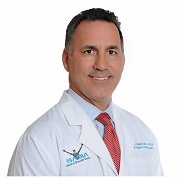Hand and Upper Limb Orthopedic surgeon Dr. Alejandro Badia offers tips to reduce arm strain, avoid tennis elbow.
MIAMI (PRWEB) February 27, 2019
February 2019 – Adding a little “elbow grease” helps get the job done but repetitively using too much “grease” can eventually lead to disabling elbow pain. So, says Florida-based orthopedic surgeon Alejandro Badia MD, who calls the medical condition “lateral epicondylitis” or “tennis elbow,” a persistent, debilitating injury that may develop in anyone who repeatedly overtaxes tendons and muscles in the forearm and elbow. Forearm muscles control the extension and bending of the wrist; tendons connect muscles to bones.
Tennis elbow primarily affects the extensor carpi radialis brevis (ECRB) muscle and tendon, resulting in often excruciating pain on the outside (lateral side) of the arm near the elbow. Besides tennis players and other athletes, including Anglers (avid fishermen), factory workers and tradesmen, including carpenters, plumbers and painters, are prone to the injury.
“Even do-it-yourselfers who decide to tackle a long-term project such as painting the house – a job that they are unaccustomed to doing — may develop tennis elbow,” says Dr. Badia, noted expert in diseases and injuries of the upper limbs and founder and chief medical officer of the Badia Hand to Shoulder Center and OrthoNOW®.
“Repetitive bending and straightening of the elbow can stress, and eventually weaken and damage, the ERCB muscle, causing microscopic tears to develop in the tendon that connects the muscle to the elbow’s lateral epicondyle bone,” Dr. Badia explains. Dr. Badia adds that hard work doesn’t cause tennis elbow, but it does make it become more symptomatic in people who are predisposed due to minor tendon injury which reduce the blood flow to the tendons and joints.
An estimated 200,000 Americans are diagnosed each year as having the problem, which can significantly impact a person’s lifestyle, sometimes making it almost too painful to lift a mug of coffee with the affected arm or shake someone’s hand.
Scientists’ overall conclusion that a “wait-and-see” approach may be the best therapy for tennis elbow because the condition usually resolves on its own over time “is not an option for many patients,” Dr. Badia says. “It can take 12-18 months for tennis elbow to clear up without treatment. For athletes eager to get back into competition or workers whose jobs require constant use of arms, hands and wrists, time is of the essence. They cannot afford to wait months,” says Dr. Badia.
In fact, Dr. Badia has successfully treated resistant tennis elbow in professional athletes, including former world’s top-10 tennis champion Marcelo Rios, whom he recently returned to competition within about a month after using an advanced therapy – ultrasonic percutaneous tenotomy with Tenex Health’s minimally invasive technology.
Developed by Tenex Health in collaboration with the Rochester, Minnesota-based Mayo Clinic, the minimally-invasive outpatient procedure is an option for patients whose tennis elbow has not responded to initial, nonsurgical therapies.
More conservative treatments include rest, application of ice to the affected elbow area, arm-wrist stretch exercises to enhance blood supply to the ECRB tendon, anti-inflammatory medications, growth factors found in platelet rich plasma (PRP) injections and even use of radiofrequency and corticosteroid injections, Dr. Badia says.
“But in cases when the elbow tendon fails to heal because of poor blood supply, we have to remove the necrotic tissue. With the Tenex Health technology, we use ultrasonic energy ablation to literally melt away the dead material and aspirate it through a small puncture wound with an instrument approximately the size of a syringe,” Dr. Badia says. “The procedure requires less than 30 minutes to perform with the patient lightly sedated and since there are no stitches there is no scarring. “Unlike traditional surgery, which often requires months of healing, recovery from the ultrasonic procedure is “almost immediate,” with the affected elbow returning to full mobility right away and back to playing tennis within a few weeks, he says.
Of course, the best treatment for tennis elbow is prevention. That’s why Dr. Badia offers these tips to workers and recreational sports players alike:
- Warm up and do arm, wrist and even finger stretch exercises, especially prior to activities like tennis that require repetitive movements.
- Engage in exercise regiments designed to strengthen the upper limbs, including wrist and elbow.
- Learn to rely more on shoulder and upper arms to take some of the work off the elbow.
- Avoid repetitive hand and arm movements; rotate work tasks. If this is not possible, take breaks and even consider wearing an elbow brace.
- Use on-the-job tools and sports equipment that are right for your grip and help take strain off the forearm muscles. For example, a lighter-weight tennis racquet with string tension of 55 pounds or less can reduce stress on both arm and elbow. Gloves or padding can absorb some of the shock when using tools. Dr. Badia also advises patients about the Xtensor reverse grip hand exerciser as a tool for recovering strength.
Dr. Badia concludes that this very popular condition can’t be avoided but early recognition and treatment are key to the best outcome and opportunity to get back to playing tennis and other sports or work activities.
Bio: Alejandro Badia, MD, FACS, internationally renowned hand and upper-limb surgeon and founder of Badia Hand to Shoulder Center and OrthoNOW®, a walk-in orthopedic care clinic. He is a member the American Society for Surgery of the Hand, American Association for Hand Surgery and the American Academy of Orthopedic Surgeons. He is a specialist in treating all problems related to the hand and upper extremity including trauma, sports injury, joint reconstruction, nerve injuries and arthroscopic surgeries. Dr. Badia is cochairing the upcoming STMS Tennis Medicine Meeting in Miami (https://www.tennismedicine.org/page/MiamiConference). http://www.drbadia.com

